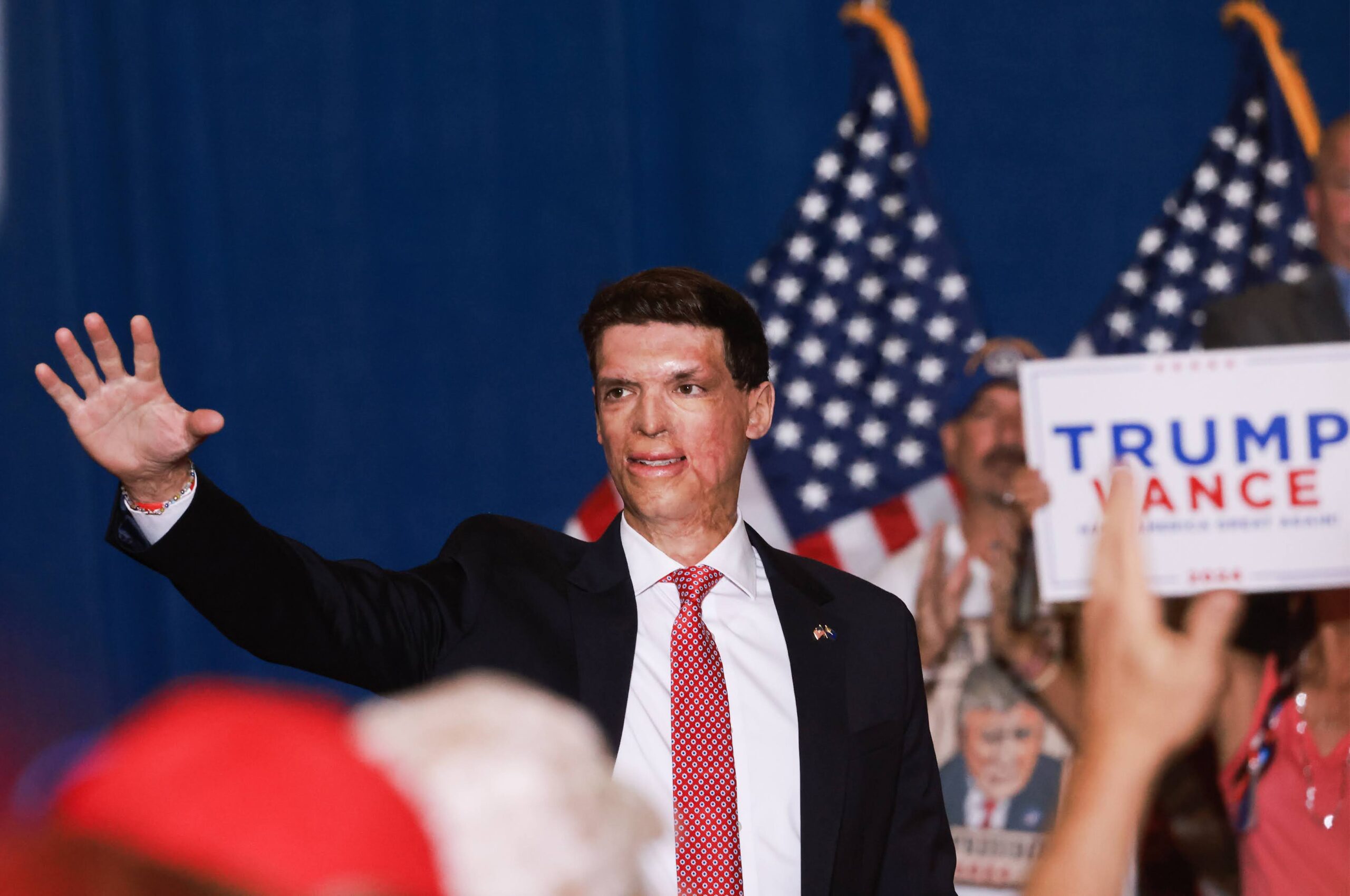Is Nevada still a swing state? Why Dems, GOP are bullish on their 2024 chances

When Vice President Kamala Harris took over from President Joe Biden as the Democratic nominee, the map of states that will decide the election remained the same — theoretically.
Team Biden believed his best — and perhaps only — path to victory would be to win the blue wall states of Pennsylvania, Michigan and Wisconsin, plus Nebraska’s second congressional district. It was a narrow path to exactly 270 electoral votes. And while the Biden campaign had still put immense resources into its Nevada field operation, polling persistently showed Trump winning, to the point that the former president had stopped considering it as a swing state.
Meanwhile, Senate Republicans have had Nevada circled and underlined for months. With Senate Democrats defending seven seats in red or purple states, Republicans have maintained that behind only Montana and Ohio, Sen. Jacky Rosen’s (D-NV) seat is their next best opportunity to flip.
Harris’ ascendancy has key Democratic figures convinced that Nevada is now not only in play in the presidential race, but eminently winnable. But the new dynamic hasn’t dashed Republicans’ hopes.
The conclusion? Between an interview with National Republican Senatorial Chair (NRSC) Steve Daines (R-MT) and new Democratic memos, it’s clear that both parties believe #WeMatter more than ever.
Daines on NV Senate
Daines took over the NRSC after a disastrous 2022 cycle for Senate Republicans in which they lost theoretically winnable races in Pennsylvania, Arizona, Georgia (twice) and, by a margin of less than 1 percentage point, Nevada.
As chairman, Daines and the NRSC got actively involved in primaries in order to avoid the “candidate quality” problem that plagued them in 2022, particularly in states such as Georgia and Pennsylvania where untested celebrities won primaries. In Nevada, they actively recruited and supported veteran Sam Brown, who challenged eventual GOP nominee Adam Laxalt, the state’s former attorney general, in 2022.
In an interview last week with regional reporters, Daines was bullish on Brown’s prospects due to three factors — rising Republican voter registration, expected presidential year turnout and existing polling dynamics.
“Sam Brown’s going to have a good chance to win that seat,” Daines said.
When Sen. Catherine Cortez Masto (D-NV) beat Laxalt, Democrats had a 9 percent voter registration lead among active voters in Clark County. Today, that figure has fallen to 7.4 percent. In a state where the final statewide margins can be incredibly slim, Daines believes that change is meaningful.
“Laxalt lost by 8,000 votes,” Daines said. “It was the tightest Senate race in the cycle. That's four votes per precinct. That's not lost [on us] — and certainly on both sides of the ledger.”
Secondly, Daines believes that while Democrats squeezed nearly every vote they could out of the blue-trending suburbs in 2022, there are more GOP votes to be found this fall in the rural counties.
Daines said that most rural counties had turnout rates near 50 percent in 2022, but he expects around 70 percent turnout in 2024 — which might translate into a few hundred votes per county, but in the aggregate, could overpower Democratic advantages in urban areas. Lyon County, for example, had 54 percent turnout in the 2022 midterm but 75 percent in 2020. Elko County had 57 percent turnout in the midterm but 86 percent in 2020.
“Had Laxalt run in a presidential year, Laxalt would have won that race in Nevada,” Daines said.
Of course, Democrats believe they have turnout boosters of their own, particularly for the critical bloc of nonpartisan voters, who outnumber registered voters of either party. A constitutional amendment to codify the right to an abortion in the state qualified for the 2024 ballot — a tactic that has a mixed record in turning Democrats out.
The main dynamic souring Senate Republican dreams this cycle has been a stubborn polling split in the presidential and Senate races. Despite Trump leading by an average of 4 points in RealClearPolitics’ polling average, Brown trails Rosen by an average of 4 points. Rosen has led in polls all cycle, with margins ranging from 2 percentage points to 12 percentage points.
But Daines — like many political scientists — believes that level of ticket splitting is highly unlikely once ballots are actually cast, and recent history shows that in swing states especially, the margins of the presidential and Senate races should be similar. In 2016, for example, Hillary Clinton won Nevada by a 2.42 percent margin; Cortez Masto (D-NV) won by 2.43 percentage points.
“History shows in a presidential year these races will all start to track by the time they get to the end of October,” Daines said, noting that the same party won the presidential and the Senate race in 68 of 69 statewide races during the last two presidential election cycles. “And then on Election Day, importantly, we'll be tracking pretty close with the presidential ballot.”
Still, Nevada has some semi-recent history of ticket splitting — in 2012, the state was the only one in the nation to elect a Republican senator (Sen. Dean Heller (R-NV) while going for Barack Obama in the presidential race.
Even though Brown trails in polls, Daines believes there are positive signs for Republicans. A YouGov poll from early July, before Biden dropped out, found Rosen with 47 percent of the vote, a full 7 points above Brown but a lower mark than fellow incumbent senators, suggesting to Daines that there is room for Brown to grow among undecided voters. In that same survey, Sens. Bob Casey (D-PA) and Tammy Baldwin (D-WI) stood at 50 percent of the ballot share.
“That's a big warning sign for an incumbent,” Daines said. “It also shows there's great upside for Sam Brown at the moment there — that's a name ID gap.”
That dynamic isn’t universally true across public polling. An Emerson College poll from June did show Rosen at 50 percent — the highest among Democratic Senate candidates in swing states. And Rosen is better positioned to win the name identification battle due to her vast war chest — to date, she’s outspent Brown on the airwaves by nearly $5 million despite not facing a competitive primary, and Democrats have a $30 million advantage in future television advertising reservations.
Presidential dynamics
On the other side, Nevada Democrats believe Harris’ candidacy has rejuvenated their expectations for Nevada — where no federal candidate has lost statewide since 2012.
Democratic political consultant Rebecca Lambe — the late Sen. Harry Reid’s (D-NV) longtime right hand — in a memo released Monday laid out the case for a “Western Wall” of Nevada and Arizona that can provide Harris with multiple paths to victory.
Lambe noted that pollster Nate Silver’s electoral modeling indicated that Harris has moved the needle for Democrats more in the Sunbelt than any other region. While Harris replacing Biden swung the polling average most significantly in Michigan, moving the needle 4.4 points in Democrats’ direction, Arizona and Nevada were second and third on that list. In Nevada, Harris’ candidacy moved polls 2.8 percentage points toward Democrats (though post-Biden dropout polling has been scarce in Nevada).
Implicit in the Harris-focused analysis is that the previous Biden-led ticket was faltering in Nevada. But in arguing for a Western Wall path to victory, Democrats believe prior results were tied more to Biden’s unpopularity rather than being symptomatic of deeper issues in the state for the party.
In the memo, Lambe argues that Harris’ strengths with key constituencies dovetails with Nevada’s electorate — making the state worthy of investment on the quest for 270 electoral votes.
“Nevada is younger and more diverse than any other battleground, which is why it is experiencing a significant swing toward Harris,” she wrote.
